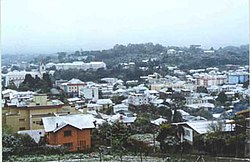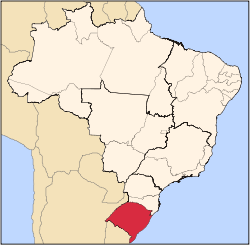Garibaldi, Rio Grande do Sul
| Garibaldi | |||
|---|---|---|---|
| Municipality | |||

The city of Garibaldi
|
|||
|
|||
 Location in the State of Rio Grande do sul |
|||
 |
|||
| Coordinates: 29°17′20″S 51°33′51″W / 29.28889°S 51.56417°WCoordinates: 29°17′20″S 51°33′51″W / 29.28889°S 51.56417°W | |||
| Country |
|
||
| Region | South | ||
| State |
|
||
| Founded | October 31, 1900 | ||
| Government | |||
| • Mayor | Cirano Cisilotto (PT) (2009-2012) | ||
| Area | |||
| • Total | 169.7 km2 (65.5 sq mi) | ||
| Elevation | 613 m (2,011 ft) | ||
| Population (2007) | |||
| • Total | 28,791 | ||
| Time zone | UTC-3 (UTC-3) | ||
| • Summer (DST) | UTC-2 (UTC-2) | ||
| HDI (2000) | 0.843–high | ||
| Website | City of Garibaldi | ||
Garibaldi is a municipality in Rio Grande do Sul, southern Brazil. It has a population of 28,714 people, most of them of Italian descent. The city is famous for its wine and champagne productions. The name Garibaldi is an homage to the Italian revolutionary Giuseppe Garibaldi and his Brazilian wife, Anita Garibaldi. It was settled by Italian immigrants, predominantly Venetians, and Prussians in the late 19th century.
In 1870, chairman Dr. João Sertório created the colonies Conde d'Eu and Dona Isabel, inaugurating a new era in the process of colonization and economy in the state of Rio Grande do Sul. Garibaldi was called, initially, Colony Conde d'Eu, in honor of the emperor's son-in-law, married to Princess Isabel. The two colonies had 32 square leagues of land. The region did not attract much interest, because its lands were rugged. It was necessary to invest in infrastructure to populate it. But as the government was not willing to do so, it sought other resources to make it habitable and arable. The government decided to populate the region with European immigrants.
The settlement of Colony Conde d'Eu occurred at the end of the imperial stage. The first immigrants arrived on July 9, 1870 and they were all Prussians (Germans). At the same period, some Amerindian families, or "Bugres" as they were commonly identified, also settled there. During this period of settlement, the Germans lived on subsistence agriculture. At that time, the only existing road, and in terrible conditions, connected Conde D'Eu to Montenegro through Maratá. By this road, in 1874 and 1875, some Swiss, Italian, French, Austrian and Polish immigrants arrived.
...
Wikipedia


